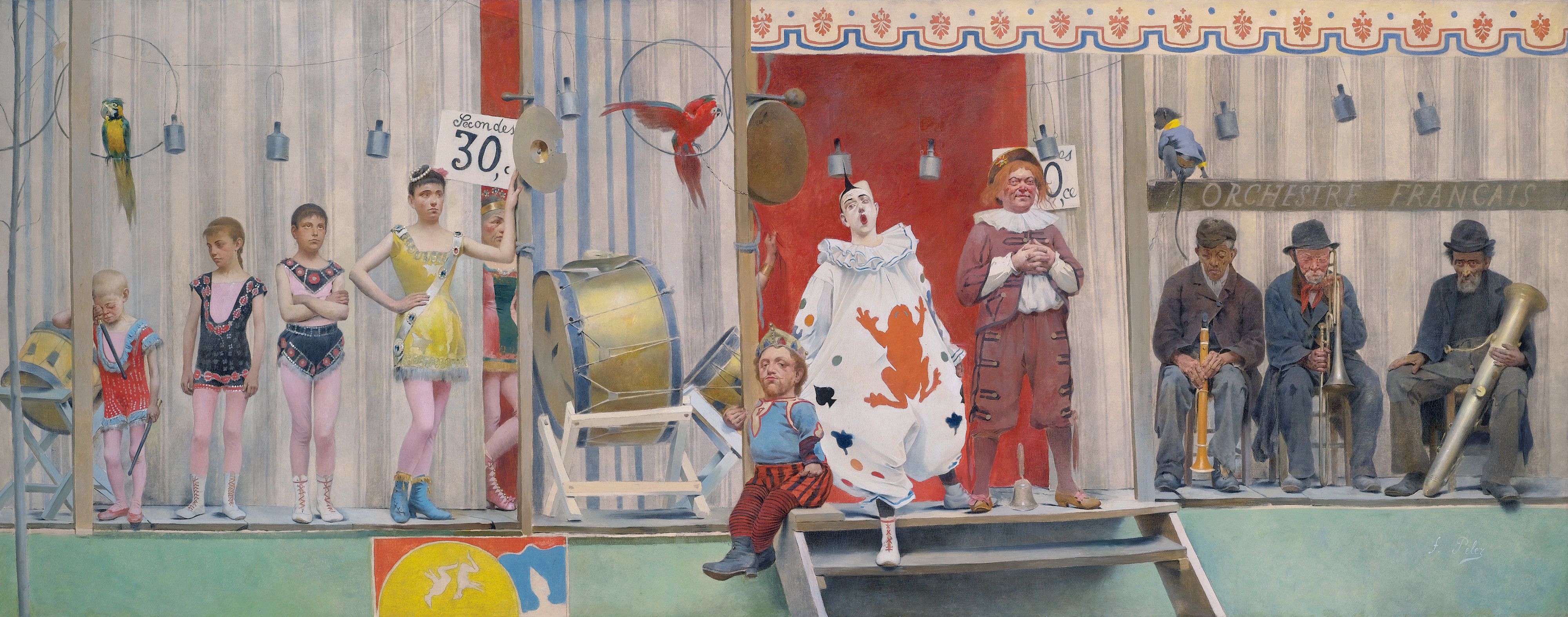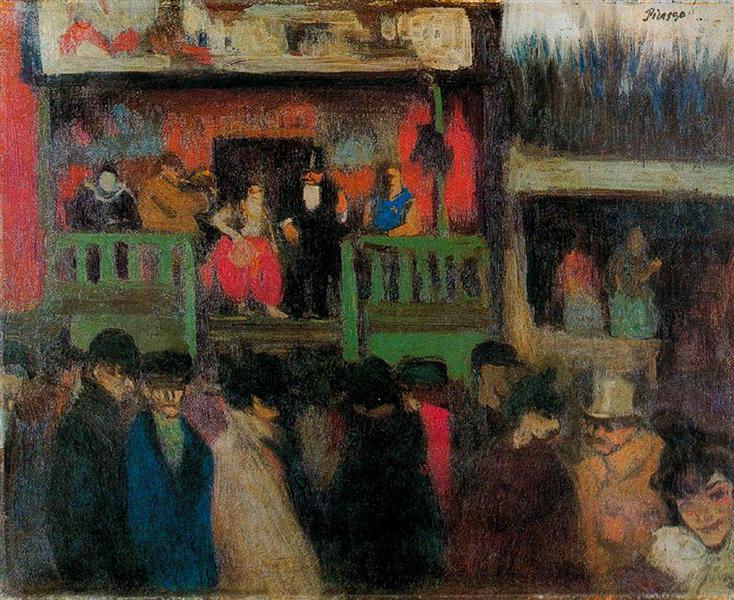The Metropolitan Museum of Art, New York
February 17 to May 29, 2017
Taking as its focus one of The Met's most captivating masterpieces, this thematic exhibition affords a unique context for appreciating the heritage and allure of
Circus Sideshow (Parade de cirque), painted in 1887–88, by Georges Seurat (1859–91).
Anchored by a remarkable group of related works by Seurat that fully illuminates the lineage of the motif in his inimitable conté crayon drawings, the presentation explores the fascination the sideshow subject held for other artists in the 19th century, ranging from the great caricaturist Honoré Daumier at mid-century to the young Pablo Picasso at the fin de siècle.
This rich visual narrative unfolds in a provocative display of more than 100 paintings, drawings, prints, period posters, and illustrated journals, supplemented by musical instruments and an array of documentary material intended to give a vivid sense of the seasonal fairs and traveling circuses of the day.
Among the highlights is Fernand Pelez's epic Grimaces and Misery—The Saltimbanques (Petit Palais, Paris), of exactly the same date as Seurat's magisterial work and, with its life-size performers aligned in friezelike formation across a 20-foot stage, a match for his ambition. Seurat's Circus Sideshow will be on view at The Metropolitan Museum of Art, New York, from February 17 to May 29, 2017.
Circus Sideshow is one of only a half-dozen major figure compositions that date to Seurat's short career. More compact in scale and more evocative in expression than his other scenes of modern life—which he regarded as "toiles de lutte" (canvases of combat)—the painting effectively announced the Neo-Impressionist's next line of attack on old guard turf, signaling a shift in focus away from the sunlit banks of the Seine to the heart of urban Paris.
Circus Sideshow initiated a final trio of works devoted to popular entertainment and led the fray as the first to tackle a nighttime setting with the benefit of his innovative technique, alternatively called pointillism or divisionism (the former term emphasizing the dotted brushwork, the latter, the theory behind separating, or dividing, color into discrete touches that would retain their integrity and brilliance). It was his singular experiment in painting outdoor, artificial illumination. The result is disarming. In relying on his finely tuned approach to evoke the effects of ethereal, penumbral light in this evening fairground scene of the Corvi Circus troupe and their public at the Gingerbread Fair in Paris, Seurat produced his most mysterious painting. From the time it debuted at the Salon des Indépendants in Paris in 1888, it has unfailingly intrigued, perplexed, and mesmerized its viewers. Seurat's closest associates, seemingly dumbstruck, largely confined their spare remarks to its novelty as a "nocturnal effect." The laconic artist never mentioned the picture.
Circus Sideshow depicts the free, teaser entertainment set up outside the circus tent to entice passersby to purchase tickets—known in French as a parade and loosely translated as the "come-on" or sideshow. At far right, customers queue up on the stairs to the box office. On the makeshift stage, under the misty glow of nine twinkling gaslights, five musicians, a ringmaster, and clown play to the assembled crowd of onlookers whose assorted hats add a wry and rhythmic note to the foreground of this austere and rigorously geometric composition. As viewers, we observe the show—as if from the rear of the audience, a part of the crowd.
Seurat took a raucous spectacle that depended on direct appeal, the banter of barkers and rousing music, jostling crowds, and makeshift structures, and he silenced the noise, rendered the staging taut and ordered, hieratic and symmetrical, exquisitely measured and classically calm. Enveloped by the hazy gloom of night, the players and public are presented with the solemnity of an ancient ritual.
For all its uncommon beauty and striking invention, Circus Sideshow courts conventions and associations that were commonplace in representations of the parade. Throughout the 19th century it had been a stock motif in popular print culture, notably for social and political caricature, where it became an acute device for parodying politicians, who like saltimbanques, are trying to sell something.
During the 1880s, the parade subject gained ground: it was given a contemporary edge by popular illustrators; it was painted with riveting descriptive detail by artists who sought success at the annual Paris Salon with works that had broad appeal; and it was mined, with spirited stylistic rivalry, by artists who jockeyed for position in the avant-garde. In the 1890s, the great era of the poster, the subject attracted a new wave of creative talents eager to establish their reputations through success in the commercial world. The poster was modern printing technology's extension of the time-honored parade; both functioned to pull the public into the show.
The presentation brings this rich illustrated history to bear on Seurat's Circus Sideshow in a context designed to elucidate the genesis of his composition and to puzzle out the sources and parallels for his haunting and enigmatic work.
The exhibition is organized chronologically, with Circus Sideshow at center stage. It will be displayed in tandem with 17 works by Seurat that exceptionally reunite the painting with the conté crayon drawings most closely related to his conception, including preparatory studies, independent sheets that trace his exploration of the motif, and the glorious café-concert drawings that were shown alongside the picture at the Salon des Indépendants in 1888. The same venue featured
Seurat's Models (Poseuses), now in The Barnes Foundation (and precluded from travel), which will be represented in the exhibition by the gemlike small version (private collection). This core group of works is seen with relation to contemporaneous images of the Corvi Circus and the Gingerbread Fair, offering a keen sense of time and place.
As the exhibition will highlight, through loans from nearly 50 public and private collections, Seurat's choice of subject attracted a steady stream of artists in the 19th century—from caricaturists, popular illustrators, and poster designers to painters of like ambition—determined to make their mark on the Paris art scene. Daumier, who set a powerful precedent at mid-century, is handsomely represented by satirical lithographs, as well as pithy paintings and watercolors that chart the saga of itinerant circus performers dependent on the fickle whims of the public. His pace-setting imagery and initiatives find a recurrent echo throughout the exhibition, which is punctuated by a veritable encore performance in the cast of players showcased in graphic works by Henri-Gabriel Ibels dating to the early 1890s.
The appeal the parade motif held for Seurat's Parisian contemporaries will be seen to great effect.In addition to works by other vanguard artists, such as Louis Anquetin, Emile Bernard, Pierre Bonnard, Jules Chéret, Louis Hayet, Lucien Pissarro, and Paul Signac, or those on the cusp, such as Jean-Louis Forain and Jean-François Raffaëlli, the presentation features recently rediscovered pictures shown in the Paris Salons of 1884 and 1885, long lost from sight by artists little-known today, as well as the unprecedented showing in the United States of Fernand Pelez's monumental Grimaces and Misery—The Saltimbanques (Petit Palais, Paris),(above) which was on view at the Salon of 1888, the same spring as Seurat's brooding masterpiece debuted at the Salon des Indépendants.
As a reminder that the "show goes on," the exhibition ends with early works by two artists who continued to explore the parade and its timeless portrayal of the pathos of comic spectacle well into the 20th century:
Picasso's moody nighttime scene, Fairground Stall (Museu Picasso, Barcelona), painted on his first visit to Paris in 1900,
and Georges Rouault's bravura Sideshow (Parade) of ca. 1907–10 (Centre Pompidou, Musée National d'Art Moderne, Paris).
Seurat's Circus Sideshow may be seen as the natural successor to exhibitions that have had as their focus other great paintings by the Neo-Impressionist artist: Seurat and The Bathers in 1997 at the National Gallery, London, and Seurat and the Making of La Grande Jatte at The Art Institute of Chicago in 2004. The scale and scope of The Met's presentation have been tailored to vivify a painting that is smaller in size and highly evocative in subject.
The current one-venue show may also be appreciated with relation to other recent projects, such as Cézanne's Card Players (2011), Madame Cézanne (2014–15), and Van Gogh: Irises and Roses (2015) that have likewise furnished a fresh context for appreciating the heritage of best-known and loved 19th-century paintings in The Met's collection.
Exhibition Credits and Related Information
Seurat's Circus Sideshow is organized by Susan Alyson Stein, Engelhard Curator of Nineteenth-Century European Painting, Department of European Paintings, The Metropolitan Museum of Art, and guest curator Richard Thomson, Watson Gordon Professor of Fine Art at the University of Edinburgh, with the assistance of Laura D. Corey, Research Assistant, Department of European Paintings, The Metropolitan Museum of Art.
It will be accompanied by a catalogue published by The Metropolitan Museum of Art and distributed by Yale University Press.



Comments
Post a Comment